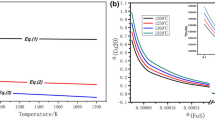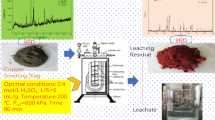Abstract
The pyrometallurgical processing of copper concentrates generates large amounts of iron and copper-containing slag. It is an available way to separate and recover iron and copper by oxidative modification slag. The copper slag used in this experiment is water-quenched copper slag tailings. The method of the experiment is to separate copper and iron in the copper slag by oxidation-magnetic separation method, and the amount of copper and iron recovered in the later stage is also greatly reduced. Mineralogical phase transform of copper slag during oxidation modification process has been investigated with the goal to provide valuable information for the recovery of copper and iron. The influence of temperature and time on the mineral phase transformation has mainly been studied during the oxidation modification. XRD combined with FT-IR has been used to characterise the mineral phase change. The experimental results showed that the oxidation temperature and time were favorable for modification of copper slag under medium- and low-temperature conditions. When the oxidation temperature was 950 °C, fayalite was transformed to hematite and quartz, which provided the necessary conditions for separating iron and silicon, and copper embedded in fayalite was also released. In addition, the copper slag particles were significantly grown under the action of oxidation reaction which was also beneficial to subsequent selection and treatment.









Similar content being viewed by others
References
World Bureau of Metal Statistics. January to December 2017 Metals Balances.
Liu G, and Zhu R, Min Metall17 (2008) 59.
Mackwell S J, Phys Chem Miner19 (1992) 220.
Chen Y W, World Nonferrous Met 9 (2001) 53.
Kim B S, Jo S K, Shin D, Lee JC, and Jeong SB, Int J Miner Process124 (2013) 124.
R.M.Manser, Li CG. Flotation selection of silicate minerals [J]. Foreign metal ore selection, 1979, 7: 8.
Finch C B, Clark G W, and Kopp O C, Am Mineral65 (1980) 381.
Pang J M, Guo P M, and Zhao P, Nonferrous Met (Extr Metall)3 (2013) 51.
Liao Z L, Tang P, Zhang B, Zhang H W, Shi X Y, Li Q J, and Hong X, China Nonferrous Metall41 (2012) 74.
Dalby K N, and King P L, Am Mineral91 (2006) 1783.
Chen M Y, and Li Z D, Foundry4 (1993) 9.
Banza A N, Gock E, and Kongolo K, Hydrometallurgy67 (2002) 63.
Cao H Y, Fu N X, Wang CG, Zhang L, Xia F S, Sui Z T, and Feng N X, Multipurp Util Miner Resour2 (2009) 8.
Cao H Y, Fu N X, Zhang L, Xia F S, Sui Z T, Feng N X, Chin J Process Eng9 (2009) 284.
Yang T, Hu J H, Wang H, and Li L, Chin J Process Eng 11 (2011) 613.
Deng Z Y, Adv Ceram 20 (1999) 11.
Mollah M Y A, Promreuk S, Schennach R, Cocke D L, and Güler R, Fuel78 (1999) 1277.
Xu C M, Wang S W, Huang X X, and Guo J K, J Inorg Mater22 (2007) 577.
Acknowledgements
The authors acknowledge the financial support of the Joint Funds of the National Natural Science Foundation of China (Grant Nos. U1760109, U1860203); Appreciation instrumental analysis & research center of Shanghai University.
Author information
Authors and Affiliations
Corresponding author
Additional information
Publisher's Note
Springer Nature remains neutral with regard to jurisdictional claims in published maps and institutional affiliations.
Rights and permissions
About this article
Cite this article
Li, Q., Yang, F., Wang, Z. et al. Study on Mechanism of Oxidation Modification of Copper Slag. Trans Indian Inst Met 72, 3223–3231 (2019). https://doi.org/10.1007/s12666-019-01788-9
Received:
Accepted:
Published:
Issue Date:
DOI: https://doi.org/10.1007/s12666-019-01788-9




